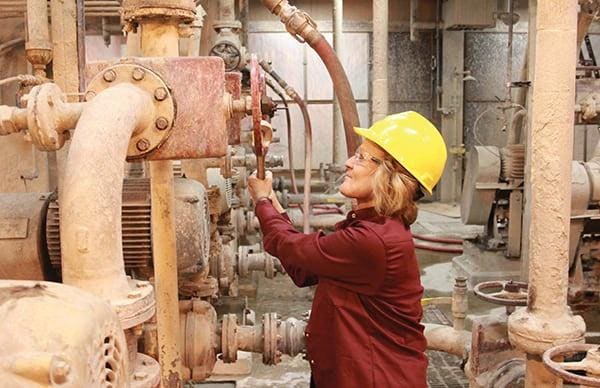How has the Inflation Reduction Act performed for the U.S. economy? As its billions of dollars, plus those from the Infrastructure Reinvestment and Jobs Act and the CHIPS and Science Act – a combined $3.5 trillion approximately – starts landing across the country, its impact and benefits are happening faster than expected, according to private sector economists.
“We were expecting infrastructure spending to hit in 2024 and 2025, but it’s making its way through the economy much faster than that,” Diane Swonk, chief economist for KPMG told the Washington Post. “We’re getting renewed strength from infrastructure spending and other stimulus that is adding to the economy in a big way.”
This funding requires recipients to ensure and track what kinds of jobs, who gets them, and being accessible to all demographics, including women, so we will know how women and women-owned businesses benefit.
Here are some facts about the economic impact of the Inflation Reduction Act, including on women:
· 6 million: The BlueGreen Alliance estimated that the IRA’s impact includes, “more than 6 million jobs created over the next 10 years by grants, loans, and tax credits and nearly 3 million jobs stimulated by new loan guarantee authority for the U.S. Department of Energy. The bill’s broad investments will also help sustain the millions of existing jobs in the clean economy.”
These include jobs in clean energy, and what they call “clean manufacturing,” “clean transportation,” and in building efficiencies, “natural infrastructure” and environmental justice. The justice jobs are likely a result of the Biden Administration’s Justice40 initiative, which requires 40% of the benefits of projects to go to disadvantaged communities.
· 170,000+: That’s the number of jobs the White House says, “Investments in clean energy and climate since the Inflation Reduction Act was signed into law have created.” The Energy Dept.’s latest “U.S. Energy and Employment Report says, “The energy sector added nearly 300,000 jobs, increasing from 7.8 million total energy jobs in 2021 to more than 8.1 million in 2022.”
· Over 50%: “Though women are underrepresented in the U.S. energy sector, they made up more than half of the new workers in 2022,“ according to the Energy Dept. report.
· 1.5 million+: That’s how many additional jobs NGO’s say the law’s funding “is projected to create” over the next 10 years. The Labor Energy Partnership (a partnership between the AFL-CIO and the Energy Futures Initiative “modeled key provisions and spending of the Inflation Reduction Act (IRA)” to estimate its impact and reports that, “the IRA will create an additional 1.5 million more jobs in the U.S. economy by 2030 compared to a Business as Usual (BAU) scenario.”
· $1 billion: That’s how much the White House says it has already awarded to “help communities become more resilient and protect them from the disastrous impacts of climate change, including drought, heat, and extreme weather.”
· $27-38 billion: That’s how much the Biden Energy Department estimates that American families will save on their electricity bills “from 2022-2030 relative to a scenario without the Inflation Reduction Act.”
· $242 billion: That’s the amount that companies have announced in new clean power capital investments since the IRA was passed, including for “at least 191 new clean energy projects in 41 states, as documented by Climate Power,” according to the Center for American Progress (CAP).
· 66: This is the number of new battery manufacturing sites in the U.S. announced so far – 65, according to the Center for American Progress in places like Tucson, Arizona; Rochester, New York; and Florence County, South Carolina. Plus, General Motors announced a new battery plant being built in Indiana.
· 40: This is the number of new or expanded electric vehicle manufacturing facilities, including in Savannah, Georgia, and Montgomery, Alabama.
· 34: These are expanded wind and solar manufacturing in places such as Pensacola, Florida; Hutchinson, Kansas; and Georgetown, Texas.
· 993,000: That’s how many more mothers were working in December 2022 than in December 2021, according to CAP.11
· $562 million: That is the amount that The National Oceanic and Atmospheric Administration (NOAA) awarded with funding from both the Inflation Reduction Act and Infrastructure Investment Act to help local communities increase their resilience to climate change, which will directly help protect families.
How many of these contracts go to women-owned business?
That is yet to be determined because the money is in the process of flowing out. The White House CEA added that, “The Small Business Administration aims to award at least 5% of all federal contracting dollars to women-owned small businesses each year. In 2022, to help meet this goal, it expanded to 140 Women’s Business Centers – the most in the Agency’s history – to provide extensive-on-the-ground expertise, in addition to 68 district offices and over 1,000 resource partners centers. And under President Biden, the SBA released disaggregated data across industries and sectors by race and ethnicity for the first time—and helped deliver contracting reforms that will require federal agencies to track and publicly report how they’re bringing in new contractors, develop diversification strategies, and open doors for more underserved firms.”
Will these economic benefits resonate with the American people, and voters?
They seem to be. A Navigator study found that 65% support the Inflation Reduction Act, including 64% of Independents and 35% of Republicans. A Yale study found 68% of registered voters support the IRA, including 75% of women, once they understood what was in it.
Read the full article here





